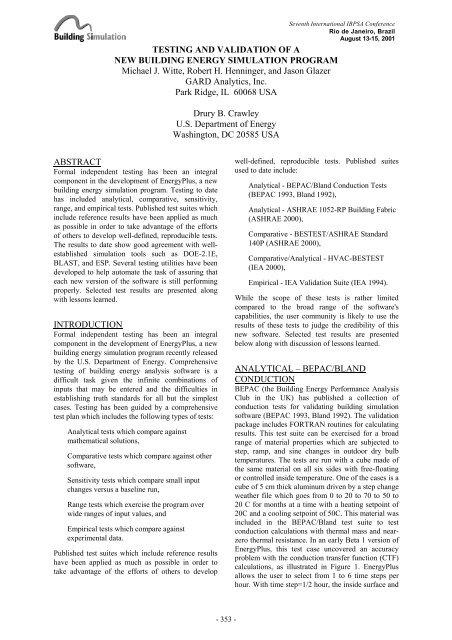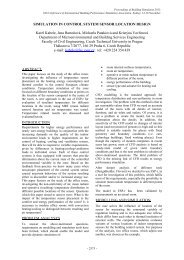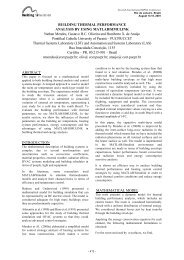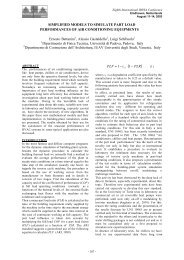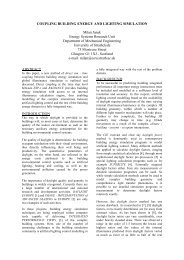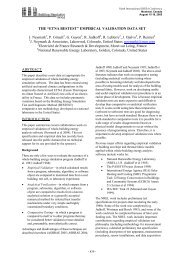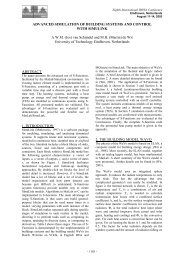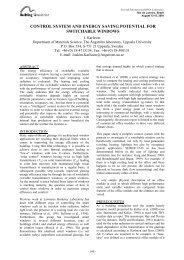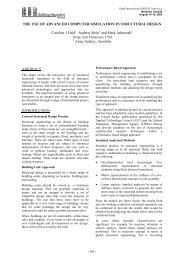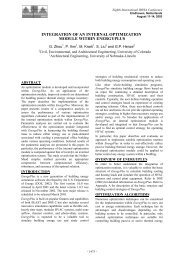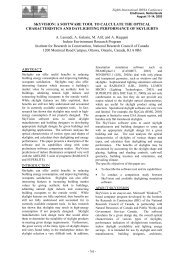testing and validation of a new building energy simulation ... - ibpsa
testing and validation of a new building energy simulation ... - ibpsa
testing and validation of a new building energy simulation ... - ibpsa
You also want an ePaper? Increase the reach of your titles
YUMPU automatically turns print PDFs into web optimized ePapers that Google loves.
TESTING AND VALIDATION OF A<br />
NEW BUILDING ENERGY SIMULATION PROGRAM<br />
Michael J. Witte, Robert H. Henninger, <strong>and</strong> Jason Glazer<br />
GARD Analytics, Inc.<br />
Park Ridge, IL 60068 USA<br />
Drury B. Crawley<br />
U.S. Department <strong>of</strong> Energy<br />
Washington, DC 20585 USA<br />
Seventh International IBPSA Conference<br />
Rio de Janeiro, Brazil<br />
August 13-15, 2001<br />
ABSTRACT<br />
Formal independent <strong>testing</strong> has been an integral<br />
component in the development <strong>of</strong> EnergyPlus, a <strong>new</strong><br />
<strong>building</strong> <strong>energy</strong> <strong>simulation</strong> program. Testing to date<br />
has included analytical, comparative, sensitivity,<br />
range, <strong>and</strong> empirical tests. Published test suites which<br />
include reference results have been applied as much<br />
as possible in order to take advantage <strong>of</strong> the efforts<br />
<strong>of</strong> others to develop well-defined, reproducible tests.<br />
The results to date show good agreement with wellestablished<br />
<strong>simulation</strong> tools such as DOE-2.1E,<br />
BLAST, <strong>and</strong> ESP. Several <strong>testing</strong> utilities have been<br />
developed to help automate the task <strong>of</strong> assuring that<br />
each <strong>new</strong> version <strong>of</strong> the s<strong>of</strong>tware is still performing<br />
properly. Selected test results are presented along<br />
with lessons learned.<br />
INTRODUCTION<br />
Formal independent <strong>testing</strong> has been an integral<br />
component in the development <strong>of</strong> EnergyPlus, a <strong>new</strong><br />
<strong>building</strong> <strong>energy</strong> <strong>simulation</strong> program recently released<br />
by the U.S. Department <strong>of</strong> Energy. Comprehensive<br />
<strong>testing</strong> <strong>of</strong> <strong>building</strong> <strong>energy</strong> analysis s<strong>of</strong>tware is a<br />
difficult task given the infinite combinations <strong>of</strong><br />
inputs that may be entered <strong>and</strong> the difficulties in<br />
establishing truth st<strong>and</strong>ards for all but the simplest<br />
cases. Testing has been guided by a comprehensive<br />
test plan which includes the following types <strong>of</strong> tests:<br />
<br />
<br />
<br />
<br />
<br />
Analytical tests which compare against<br />
mathematical solutions,<br />
Comparative tests which compare against other<br />
s<strong>of</strong>tware,<br />
Sensitivity tests which compare small input<br />
changes versus a baseline run,<br />
Range tests which exercise the program over<br />
wide ranges <strong>of</strong> input values, <strong>and</strong><br />
Empirical tests which compare against<br />
experimental data.<br />
Published test suites which include reference results<br />
have been applied as much as possible in order to<br />
take advantage <strong>of</strong> the efforts <strong>of</strong> others to develop<br />
well-defined, reproducible tests. Published suites<br />
used to date include:<br />
<br />
<br />
<br />
<br />
Analytical - BEPAC/Bl<strong>and</strong> Conduction Tests<br />
(BEPAC 1993, Bl<strong>and</strong> 1992),<br />
Analytical - ASHRAE 1052-RP Building Fabric<br />
(ASHRAE 2000),<br />
Comparative - BESTEST/ASHRAE St<strong>and</strong>ard<br />
140P (ASHRAE 2000),<br />
Comparative/Analytical - HVAC-BESTEST<br />
(IEA 2000),<br />
Empirical - IEA Validation Suite (IEA 1994).<br />
While the scope <strong>of</strong> these tests is rather limited<br />
compared to the broad range <strong>of</strong> the s<strong>of</strong>tware's<br />
capabilities, the user community is likely to use the<br />
results <strong>of</strong> these tests to judge the credibility <strong>of</strong> this<br />
<strong>new</strong> s<strong>of</strong>tware. Selected test results are presented<br />
below along with discussion <strong>of</strong> lessons learned.<br />
ANALYTICAL – BEPAC/BLAND<br />
CONDUCTION<br />
BEPAC (the Building Energy Performance Analysis<br />
Club in the UK) has published a collection <strong>of</strong><br />
conduction tests for validating <strong>building</strong> <strong>simulation</strong><br />
s<strong>of</strong>tware (BEPAC 1993, Bl<strong>and</strong> 1992). The <strong>validation</strong><br />
package includes FORTRAN routines for calculating<br />
results. This test suite can be exercised for a broad<br />
range <strong>of</strong> material properties which are subjected to<br />
step, ramp, <strong>and</strong> sine changes in outdoor dry bulb<br />
temperatures. The tests are run with a cube made <strong>of</strong><br />
the same material on all six sides with free-floating<br />
or controlled inside temperature. One <strong>of</strong> the cases is a<br />
cube <strong>of</strong> 5 cm thick aluminum driven by a step change<br />
weather file which goes from 0 to 20 to 70 to 50 to<br />
20 C for months at a time with a heating setpoint <strong>of</strong><br />
20C <strong>and</strong> a cooling setpoint <strong>of</strong> 50C. This material was<br />
included in the BEPAC/Bl<strong>and</strong> test suite to test<br />
conduction calculations with thermal mass <strong>and</strong> nearzero<br />
thermal resistance. In an early Beta 1 version <strong>of</strong><br />
EnergyPlus, this test case uncovered an accuracy<br />
problem with the conduction transfer function (CTF)<br />
calculations, as illustrated in Figure 1. EnergyPlus<br />
allows the user to select from 1 to 6 time steps per<br />
hour. With time step=1/2 hour, the inside surface <strong>and</strong><br />
- 353 -
air temperatures responded as expected to the<br />
changes in outdoor temperature. But with time<br />
step=1 hour, impossible conditions occurred, for<br />
example, outdoor=70C, indoor=20C, <strong>and</strong><br />
surfaces=18C. This error has been fixed as a result <strong>of</strong><br />
these tests.<br />
ANALYTICAL – ASHRAE 1052RP<br />
BUILDING FABRIC<br />
The American Society <strong>of</strong> Heating, Refrigerating, <strong>and</strong><br />
Air-Conditioning Engineers (ASHRAE) sponsored<br />
research project 1052RP to develop analytical tests<br />
for the <strong>building</strong> fabric (ASHRAE 2000). At the time<br />
<strong>of</strong> this writing, the project was nearly complete,<br />
including documentation describing 16 tests <strong>and</strong> a<br />
s<strong>of</strong>tware toolkit to generate analytical results. The<br />
tests cover a variety <strong>of</strong> <strong>building</strong> envelope<br />
mechanisms including conduction, convection, solar<br />
gains, shading, infiltration, internal gains, radiant<br />
transfer, <strong>and</strong> ground coupling. While a variety <strong>of</strong><br />
analytical conduction tests have been published<br />
before, this is the first test suite to provide analytical<br />
solutions for the other areas. These tests were applied<br />
to EnergyPlus as part <strong>of</strong> the review process for the<br />
research project. Several bugs were found in<br />
EnergyPlus while applying the tests, <strong>and</strong> the results<br />
<strong>of</strong> some <strong>of</strong> the tests have raised questions requiring<br />
further investigation. Figure 2 shows the results <strong>of</strong><br />
one <strong>of</strong> the transient conduction tests. In this test, the<br />
initial conditions are 20C outdoor dry bulb <strong>and</strong><br />
indoor temperature is controlled to 20C. After<br />
several months at the initial condition, the outdoor<br />
Temperature [C]<br />
80<br />
70<br />
60<br />
50<br />
40<br />
30<br />
20<br />
10<br />
Timestep=1 hr<br />
temperature is stepped up to 70C. Inside <strong>and</strong> outside<br />
surface temperatures <strong>and</strong> zone cooling load are<br />
compared to the analytical solution over the next<br />
several days. For this case, the general response <strong>of</strong><br />
the <strong>simulation</strong> is good, <strong>and</strong> the two solutions come<br />
together after 30 to 40 hours. But there are some<br />
small differences during the transition period with<br />
inside temperature differing by as much as 1.3C in<br />
the sixth hour after step-up. Yet the integrated<br />
cooling load agrees within 0.5% for the first 24 hours<br />
<strong>and</strong> within 0.05% for the first 48 hours. For some<br />
special purposes, the 1.3C surface temperature error<br />
may be significant, but for the vast majority <strong>of</strong><br />
applications any errors seen here are insignificant.<br />
The 1052RP toolkit allows the user <strong>of</strong> the test suite to<br />
generate results for a wide range <strong>of</strong> material<br />
properties. It is important to exercise the <strong>simulation</strong><br />
tool for a wide range <strong>of</strong> combinations <strong>of</strong> mass,<br />
conductivity, <strong>and</strong> thickness in order to uncover<br />
hidden instabilities.<br />
Figure 3 shows results for one <strong>of</strong> the window solar<br />
gain tests with south facing glass on August 21. The<br />
solar incident on the exterior <strong>and</strong> the solar<br />
transmitted by the window are compared throughout<br />
the day. Note the time shift between the simulated<br />
<strong>and</strong> analytical results for this case. This was observed<br />
for many <strong>of</strong> the solar-related tests. Initially this was<br />
thought to be a daylight savings time error, but that<br />
has been ruled out. A possible cause may be the<br />
interpolation between hourly weather data for subhourly<br />
time steps. The development team is<br />
investigating this issue.<br />
Outdoor Air<br />
Temperature<br />
Indoor Air<br />
Temperature<br />
Inside Surface<br />
Temperature<br />
Note:Teststructureisacube<br />
2m by 2m by 2m with four<br />
walls, ceiling <strong>and</strong> floor all the<br />
same thickness <strong>and</strong> made <strong>of</strong><br />
the same 5 cm aluminum<br />
material <strong>and</strong> with the same<br />
boundary conditions. All six<br />
surfaces are exposed to<br />
external conditions.<br />
Temperature [C]<br />
80<br />
70<br />
60<br />
50<br />
40<br />
30<br />
20<br />
10<br />
Timestep=1/2 hr<br />
0<br />
0 25 50 75 100 125 150 175 200<br />
Day <strong>of</strong> Year<br />
EnergyPlus Version: Beta 1 Build 005<br />
0<br />
0 25 50 75 100 125 150 175 200<br />
Day <strong>of</strong> Year<br />
Figure 1 Results from BEPAC/Bl<strong>and</strong> Conduction Test with 5cm <strong>of</strong> aluminum showing early CTF<br />
accuracy problem. In an early Beta 1 version <strong>of</strong> EnergyPlus, the BEPAC/Bl<strong>and</strong> conduction test suite uncovered<br />
an accuracy problem with the CTF calculations with a construction <strong>of</strong> 5cm <strong>of</strong> aluminum. With time step=1/2<br />
hour, the inside surface <strong>and</strong> air temperatures responded as expected. But with time step=1 hour, impossible<br />
conditions occurred, e.g. outdoor=70C, indoor=20C, surfaces=18C. This error has been fixed.<br />
- 354 -
450<br />
70<br />
400<br />
Outdoor Dry Bulb<br />
Temperature<br />
350<br />
EnergyPlus Outside<br />
Surface Temperature<br />
60<br />
Temperature (C)<br />
50<br />
40<br />
300<br />
250<br />
200<br />
150<br />
Zone Load (W)<br />
ASHRAE 1052RP<br />
Outside Surface<br />
Temperature<br />
EnergyPlus Inside<br />
Surface Temperature<br />
ASHRAE 1052RP Inside<br />
Surface Temperature<br />
30<br />
100<br />
EnergyPlus Sensible<br />
Cooling Load<br />
20<br />
2150 2160 2170 2180 2190 2200<br />
Hour <strong>of</strong> Year<br />
50<br />
0<br />
ASHRAE 1052RP<br />
Sensible Cooling Load<br />
EnergyPlus Version 1.0 Build 023<br />
Figure 2 Results from ASHRAE 1052RP Analytical Test Suite - Transient Conduction TC2, 10 cm Wood,<br />
50C Step Up Change in External Temperature, Indoor Temperature Constant at 20C. For this case,<br />
excellent agreement is shown. The 1052RP toolkit allows the user <strong>of</strong> the test suite to generate results for a wide<br />
range <strong>of</strong> material properties.<br />
400<br />
350<br />
300<br />
Solar Radiation (W/m2)<br />
250<br />
200<br />
150<br />
100<br />
50<br />
EnergyPlus Incident Solar<br />
ASHRAE 1052 Incident Solar<br />
EnergyPlus Sensible Cooling Load<br />
ASHRAE 1052 Sensible Cooling<br />
Load<br />
0<br />
5:00 6:00 7:00 8:00 9:00 10:00 11:00 12:00 13:00 14:00 15:00 16:00 17:00 18:00 19:00<br />
Time <strong>of</strong> day<br />
EnergyPlus Version 1.0 Build 023<br />
Figure 3 Results from ASHRAE 1052RP Analytical Test Suite - Window Solar Gain, Atlanta, August 21,<br />
South Facing 3.175 mm (1/8 inch) Clear Single-Pane Glass. Note the time shift between the simulated <strong>and</strong><br />
analytical results. Possible cause may be interpolation between hourly weather data for sub-hourly time steps.<br />
- 355 -
COMPARATIVE – BESTEST/ASHRAE<br />
STD 140<br />
The BESTEST suite developed through an<br />
International Energy Agency (IEA) project (IEA<br />
1995) is a comparative set <strong>of</strong> tests run on single-zone<br />
<strong>and</strong> double-zone shoebox configurations with<br />
variations in mass, windows, overhangs, <strong>and</strong> fins.<br />
BESTEST has been restated as a St<strong>and</strong>ard Method <strong>of</strong><br />
Test in ASHRAE St<strong>and</strong>ard 140-2001 (ASHRAE<br />
2001). Reference results for eight different<br />
<strong>simulation</strong> programs are included with the st<strong>and</strong>ard<br />
to provide a comparison point for <strong>testing</strong> other<br />
s<strong>of</strong>tware. Although not part <strong>of</strong> the original BESTEST<br />
set <strong>of</strong> results, results for later versions <strong>of</strong> BLAST<br />
(3.0 level 334) <strong>and</strong> DOE2 (DOE-2.1E) have been<br />
added. For each test case, results for annual cooling<br />
load, annual heating load, peak cooling load, <strong>and</strong><br />
peak heating load are compared. In addition, there<br />
are some free-floating cases where maximum <strong>and</strong><br />
minimum temperatures are compared instead <strong>of</strong> load.<br />
Annual cooling results for low mass <strong>building</strong><br />
construction are presented in Figure 4. Each cluster<br />
<strong>of</strong> bars shows the results from all programs for a<br />
particular case. In general, EnergyPlus results are<br />
within the range <strong>of</strong> the other tested programs.<br />
Applying this test suite helped identify several bugs<br />
<strong>and</strong> documentation deficiencies, e.g. shade fin<br />
surface coordinates were inverted. Figure 5 shows<br />
how the EnergyPlus results changed with various<br />
versions <strong>of</strong> EnergyPlus. Notice in Case 630 how the<br />
cooling load dropped when the fin shading<br />
coordinate problem was corrected in version 1-14.<br />
COMPARATIVE/ANALYTICAL – HVAC<br />
BESTEST<br />
The HVAC BESTEST suite, in development through<br />
an IEA project, tests the cooling loads <strong>and</strong> electric<br />
power consumption for a single-zone DX cooling<br />
system with a dry or wet coil under varying<br />
conditions <strong>of</strong> entering dry bulb, outdoor dry bulb,<br />
part-load ratio (PLR), <strong>and</strong> sensible heat ratio (SHR).<br />
Figure 6 shows the space cooling electricity<br />
consumption (including indoor fan, compressor, <strong>and</strong><br />
outdoor fan) comparisons for EnergyPlus versus<br />
other tested programs <strong>and</strong> three analytical solutions.<br />
While EnergyPlus results are within the range <strong>of</strong><br />
results from the other tested programs, there are some<br />
issues related to fan <strong>energy</strong> <strong>and</strong> humidity ratio which<br />
warrant further investigation. This test suite revealed<br />
several bugs, including:<br />
<br />
<br />
<br />
<br />
<br />
Reporting problems for coil loads with cycling<br />
fan operation.<br />
St<strong>and</strong>ard air density not applied as documented<br />
Supply fan operation needed to include cycling<br />
adjustments<br />
Use <strong>of</strong> both dry <strong>and</strong> wet c p needed to be<br />
converted to all wet c p<br />
Heat <strong>of</strong> vaporization assumptions needed<br />
adjustment to make latent zone loads <strong>and</strong> coil<br />
loads consistent with each other.<br />
9.0<br />
Annual Cooling (MWH)<br />
8.0<br />
7.0<br />
6.0<br />
5.0<br />
4.0<br />
3.0<br />
2.0<br />
ESP<br />
BLAST<br />
BLAST3.0-334<br />
DOE2.1D<br />
DOE2.1E<br />
SRES/SUN<br />
SERIRES<br />
S3PAS<br />
TRNSYS<br />
TASE<br />
ENERGYPLUS<br />
TASE Case 630<br />
disregarded by<br />
ASHRAE St<strong>and</strong>ard<br />
140P due to known<br />
errors<br />
1.0<br />
0.0<br />
600<br />
South<br />
Windows<br />
610<br />
S. Windows +<br />
Overhang<br />
620<br />
East & West<br />
Windows<br />
630<br />
E&W Windows<br />
+ Overhang &<br />
Fins<br />
640<br />
Case 600 with<br />
H/C Temp.<br />
Setback<br />
650<br />
Case 600<br />
with Night<br />
Ventilation<br />
EnergyPlus Version 1.0 Build 023<br />
BESTEST Case<br />
Figure 4 Results from BESTEST/ASHRAE Std 140 – Low Mass Building Annual Cooling. EnergyPlus<br />
results are within the range <strong>of</strong> results from other tested programs.<br />
- 356 -
Annual Cooling (MWH)<br />
8.0<br />
7.0<br />
6.0<br />
5.0<br />
4.0<br />
3.0<br />
2.0<br />
1.0<br />
0.0<br />
600<br />
South Windows<br />
610<br />
S. Windows +<br />
Overhang<br />
620<br />
East & West<br />
Windows<br />
630<br />
E&W Windows +<br />
Overhang & Fins<br />
640<br />
Case 600 with H/C<br />
Temp. Setback<br />
Ver 1-23b<br />
Ver 1-23<br />
Ver 1-19<br />
Ver 1-17<br />
Ver 1-14<br />
Ver 1-11<br />
Ver 1-10<br />
Ver 1-09<br />
Ver 1-08<br />
Ver 1-05<br />
Beta 5-18<br />
Beta 5-09<br />
Beta 5-07<br />
Beta 5-06<br />
Beta 5-03<br />
Beta 4-16<br />
Beta 3-16<br />
Beta 2-18<br />
Beta 1-016<br />
BESTEST Case<br />
Figure 5 Comparison <strong>of</strong> Results for Various Versions <strong>of</strong> EnergyPlus for BESTEST/ASHRAE Std 140 –<br />
Low Mass Building Annual Cooling. Notice for Case 630 that annual cooling was reduced significantly when<br />
the fin shading coordinate problem was corrected in version 1-14.<br />
HVAC BESTEST Comparison<br />
Space Cooling Electricity Consumption<br />
(includes Compressor + OD Fan + ID Fan)<br />
1,800<br />
Electricity Use (kWh)<br />
1,600<br />
1,400<br />
1,200<br />
1,000<br />
800<br />
600<br />
400<br />
200<br />
CASIS/EDF<br />
CLIM2000/EDF<br />
DOE21E/CIEMAT<br />
DOE21E/NREL<br />
PROKST/KST<br />
TRNSYS-ideal/TUD<br />
TRNYS-real/TUD<br />
Analytical/TUD<br />
Analytical/HTAL1<br />
Analytical/HTAL2<br />
EnergyPlus Ver 1-23<br />
0<br />
E100<br />
Dry Coil<br />
Mid EDB<br />
High ODB<br />
High PLR<br />
E110<br />
Dry Coil<br />
Mid EDB<br />
Low ODB<br />
High PLR<br />
E140<br />
Dry Coil<br />
Mid EDB<br />
Low ODB<br />
Low PLR<br />
E150<br />
Wet Coil<br />
Mid EDB<br />
Low ODB<br />
High PLR<br />
High SHR<br />
E160<br />
Wet Coil<br />
High EDB<br />
Low ODB<br />
High PLR<br />
High SHR<br />
HVAC BESTEST Case<br />
E180<br />
Wet Coil<br />
Mid EDB<br />
Low ODB<br />
High PLR<br />
Low SHR<br />
E185<br />
Wet Coil<br />
Mid EDB<br />
High ODB<br />
High PLR<br />
Low SHR<br />
E190<br />
Wet Coil<br />
Mid EDB<br />
Low ODB<br />
Low PLR<br />
Low SHR<br />
EnergyPlus Version 1.0 Build 023<br />
Figure 6 Electricity Consumption Results for Selected HVAC BESTEST Cases. EnergyPlus results are<br />
within the range <strong>of</strong> results from the other tested programs, but there are some issues related to fan <strong>energy</strong> <strong>and</strong><br />
humidity ratio which warrant further investigation.<br />
- 357 -
SENSITIVITY AND RANGE TESTS<br />
Sensitivity <strong>and</strong> range test suites have been developed<br />
to systematically exercise many <strong>of</strong> the program<br />
inputs in order to confirm that basic program<br />
elements are functioning properly <strong>and</strong> to identify as<br />
many bugs as possible prior to public release <strong>of</strong> the<br />
s<strong>of</strong>tware. These test suites take advantage <strong>of</strong> the<br />
macro preprocessor <strong>and</strong> allow batch processing <strong>of</strong><br />
large numbers <strong>of</strong> runs with parameters passed to alter<br />
one or more values in the input file. An automated<br />
tool has been developed which will take any input<br />
file <strong>and</strong> exercise all fields for nine cases: slightly<br />
less than minimum, minimum allowed, nominal (the<br />
value originally in the input file), nominal minus<br />
50%, nominal plus 50%, maximum allowed, <strong>and</strong><br />
slightly more than maximum. The minimum <strong>and</strong><br />
maximum allowed values are determined from<br />
specifications in the EnergyPlus input data dictionary<br />
(IDD) file. A log file is generated which summarizes<br />
whether each run completed successfully, terminated<br />
with error messages, or crashed. The log file also<br />
compares the changes in output variables for the<br />
nominal <strong>and</strong> nominal minus 50% cases <strong>and</strong> uses this<br />
to predict the results for the nominal plus 50% cases.<br />
The first time this system was used, many <strong>of</strong> the runs<br />
crashed, prompting several change requests, most <strong>of</strong><br />
which were related to the IDD minimum <strong>and</strong><br />
maximum specifications <strong>and</strong> the need to terminate<br />
the <strong>simulation</strong> gracefully if temperatures go out <strong>of</strong><br />
range. With these changes implemented, crash<br />
conditions have been eliminated for the cases tested.<br />
EMPIRICAL - IEA VALIDATION SUITE<br />
The IEA Empirical Validation Package (IEA 1994)<br />
contains detailed information for two ten-day<br />
experiments using three highly monitored test rooms.<br />
The <strong>validation</strong> package was developed specifically<br />
for use in validating <strong>building</strong> <strong>energy</strong> <strong>simulation</strong><br />
s<strong>of</strong>tware. It contains detailed descriptions <strong>of</strong> the test<br />
rooms, heating equipment, <strong>and</strong> instrumentation <strong>and</strong><br />
includes a data diskette. The three rooms were<br />
equipped with single glazing, double glazing, <strong>and</strong> an<br />
opaque insulated panel. Data for two tests are<br />
provided: heated (October 17 - 26, <strong>and</strong> unheated<br />
(May 21 - 30). These test cases exercise the<br />
following components <strong>of</strong> the <strong>simulation</strong>:<br />
<br />
<br />
<br />
<br />
Opaque conduction <strong>and</strong> exterior solar gains<br />
Simple glazing, conduction <strong>and</strong> solar gains<br />
Zone heat balance without internal loads<br />
Simple heating system<br />
Input files have been developed for this test suite, but<br />
the meteorological data which comes with the test<br />
suite is not in a st<strong>and</strong>ard format. The data contains<br />
global <strong>and</strong> diffuse horizontal total radiation which<br />
must be converted to direct normal solar values for<br />
use with EnergyPlus.<br />
OTHER TESTING TOOLS<br />
Several <strong>testing</strong> utilities have been developed to help<br />
automate the task <strong>of</strong> assuring that each <strong>new</strong> version<br />
<strong>of</strong> the s<strong>of</strong>tware is still performing properly. One tool,<br />
which is used extensively by the s<strong>of</strong>tware developers,<br />
is a tool for mathematically comparing output files.<br />
Typical text file comparison tools will flag<br />
differences even when a result has only changed by a<br />
very small amount. The mathematical difference<br />
utility compares two CSV (commas separated values)<br />
format files containing <strong>simulation</strong> results. The results<br />
files will typically be for the same input file using<br />
two different versions <strong>of</strong> the s<strong>of</strong>tware. Any<br />
differences which are greater than both a specified<br />
percentage tolerance <strong>and</strong> absolute tolerance (e.g.<br />
0.5% <strong>and</strong> 0.001 difference) are flagged in a log file.<br />
This batch-oriented system allows large suites to be<br />
run before <strong>and</strong> after code changes are implemented to<br />
quickly see what results have changed significantly.<br />
This allows developers to gain confidence that<br />
changes made in one section <strong>of</strong> the program have not<br />
unintentionally changed results from another section<br />
<strong>of</strong> the program.<br />
CONCLUSIONS<br />
Formal independent <strong>testing</strong> during the development<br />
<strong>of</strong> EnergyPlus has helped produce a more robust <strong>and</strong><br />
credible <strong>simulation</strong> tool. Application <strong>of</strong> published<br />
test suites for analytical, comparative, <strong>and</strong> empirical<br />
tests has been very useful in detecting bugs <strong>and</strong><br />
confirming that basic modeling algorithms are<br />
working properly. Significant bugs found include:<br />
<br />
<br />
<br />
<br />
<br />
<br />
Conduction transfer function accuracy problem<br />
with certain material types<br />
Solar time shift<br />
Inverted coordinates for shading fins<br />
HVAC mass flow <strong>and</strong> c p inconsistencies<br />
DX coil reporting error when cycling<br />
Various code crashes with extreme inputs<br />
Even with well-documented test suites, there were<br />
<strong>of</strong>ten input details which were not specified or which<br />
did not translate directly into EnergyPlus inputs.<br />
EnergyPlus results to date generally show good<br />
agreement with well-established <strong>simulation</strong> tools<br />
such as DOE-2, BLAST, TRNSYS <strong>and</strong> ESP. The<br />
results <strong>of</strong> these tests may be used by the user<br />
community to judge the credibility <strong>of</strong> this <strong>new</strong><br />
<strong>simulation</strong> s<strong>of</strong>tware.<br />
Additional test suites <strong>and</strong> test utilities have also been<br />
developed to aid the development <strong>and</strong> debugging<br />
process. Range <strong>and</strong> sensitivity tests have helped to<br />
eliminate code crashes, <strong>and</strong> a utility for mathematical<br />
- 358 -
comparisons <strong>of</strong> results has simplified the task <strong>of</strong><br />
evaluating the impact <strong>of</strong> source code changes.<br />
ACKNOWLEDGEMENTS<br />
This work was supported by the Assistant Secretary<br />
for Energy Efficiency <strong>and</strong> Re<strong>new</strong>able Energy, Office<br />
<strong>of</strong> Building Technology, State <strong>and</strong> Community<br />
Programs, Office <strong>of</strong> Building Research <strong>and</strong><br />
St<strong>and</strong>ards <strong>of</strong> the U.S. Department <strong>of</strong> Energy, Drury<br />
Crawley, program manager.<br />
REFERENCES<br />
ASHRAE 2000. ASHRAE Analytical Test Suite –<br />
Building Fabric, 1052RP Draft Final Report,<br />
December 2000.<br />
ASHRAE 2001. ASHRAE St<strong>and</strong>ard 140, St<strong>and</strong>ard<br />
Method <strong>of</strong> Test for the Evaluation <strong>of</strong> Building Energy<br />
Analysis Computer Programs, (expected publication<br />
date August 2001).<br />
BEPAC 1993. B.H. Bl<strong>and</strong>, Conduction tests for the<br />
<strong>validation</strong> <strong>of</strong> dynamic thermal models <strong>of</strong> <strong>building</strong>s,<br />
Technical Note 93/1, August 1993.<br />
Bl<strong>and</strong> 1992. Bl<strong>and</strong>, B.H. “Conduction in dynamic<br />
thermal models: Analytical tests for <strong>validation</strong>”,<br />
Building Services Engineering Research <strong>and</strong><br />
Technology, 13(4), pp 197-208.<br />
IEA 1994. K.J. Lomas, C. Matrin, H. Eppel, M.<br />
Watson, <strong>and</strong> D. Bloomfield, Empirical Validation <strong>of</strong><br />
Thermal Building Simulation Programs Using Test<br />
Room Data, Volume 2: Empirical Validation<br />
Package, September 1994.<br />
IEA 1995. Building Energy Simulation Test<br />
(BESTEST) <strong>and</strong> Diagnostic Method, National<br />
Re<strong>new</strong>able Energy Laboratory, Golden, Colorado,<br />
February 1995.<br />
IEA 2000. J. Neymark, <strong>and</strong> R. Judk<strong>of</strong>f, International<br />
Energy Agency Building Energy Simulation Test <strong>and</strong><br />
Diagnostic Method for HVAC Equipment Models<br />
(HVAC BESTEST) Vol. 1: Cases E100-E200 (Draft),<br />
November 2000.<br />
- 359 -
- 360 -


